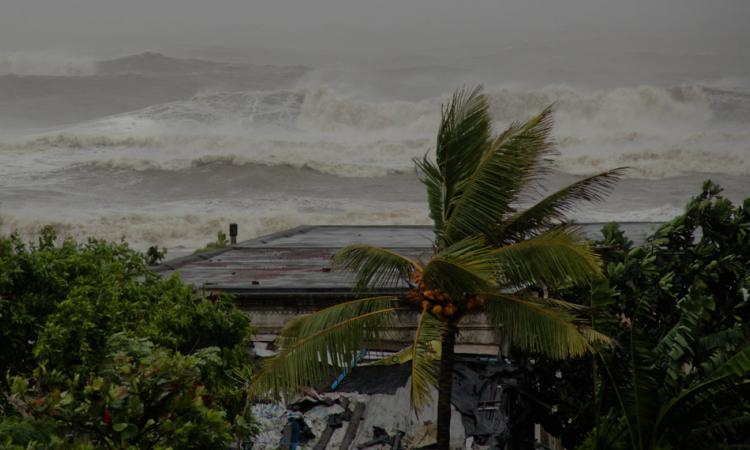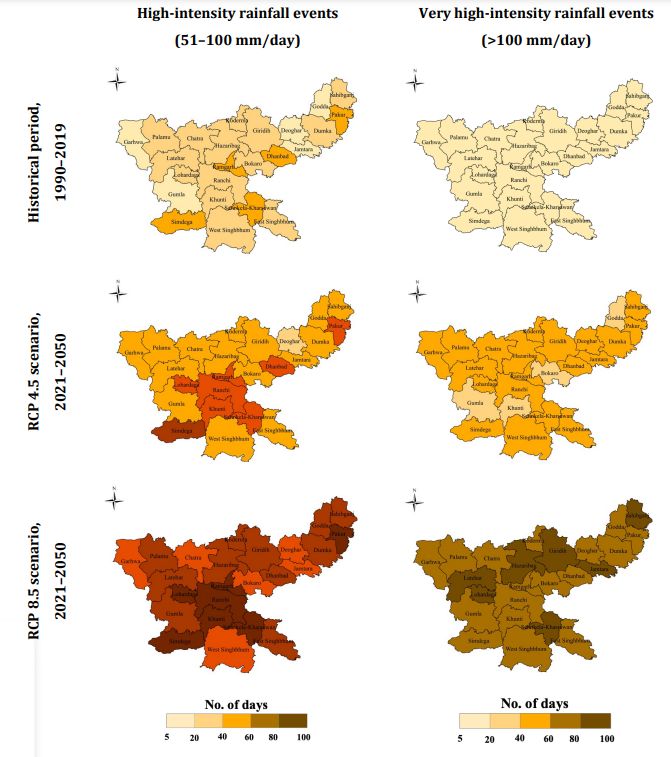
Climate data gathering at the district level is essential for risk planning, developing coping strategies, and adaptation, especially considering that the impacts of climate variability, climate change, and extreme events are visible globally and in India. To frame climate change policies, data on the impacts of climate change across different spatial and temporal scales and sectors are needed.
A good understanding of historical climate trends and climate change projections at a district scale is essential in this endeavour as much of the decision-making, planning, and implementation happens at the district level. The Government of India and state governments are committed to reducing the vulnerability of communities and ecosystems to climate change and building resilience to climate change risks.
Historically, temperature and rainfall have increased, and rainfall variability is high across all the eastern states of the India. A recent report on ‘District-Level Changes in Climate: Historical Climate and Climate Change Projections for the Eastern States of India’ indicates an overall warming of both summer and winter minimum temperatures, an increase in the number of rainy days (>2.5 mm rainfall/day), and an increase in the number of heavy rainfall events across almost all the districts of the four eastern states of India: Bihar, Jharkhand, Odisha, and West Bengal.
As per the study by Center for Study of Science, Technology and Policy (CSTEP), a private, not-for-profit based in Bangalore “rainfall variability and rainfall deficient years are projected to predominantly decline in a majority of the districts of the eastern states.”
Findings
- Summer maximum and the winter minimum temperatures are projected to increase by 1°C to 2°C in the districts of eastern India compared to the historical temperatures under the high emission RCP 8.5 scenario.
- The number of rainy days is projected to increase in the 2030s in all the districts of eastern India compared to the historical period. The increase is by 1 to 11 days under the RCP 4.5 scenario, with the maximum increase projected in West Bengal and a minimum increase projected in Odisha. The increase is by 1 to 15 days under the RCP 8.5 scenario, with the maximum increase projected in West Bengal.
Rainfall during kharif (June to September) and rabi (October to December) seasons is projected to increase in the 2030s in almost all the districts of eastern India compared to the historical period. The projected increase in the kharif season rainfall is by 1% to 46% under the RCP 4.5 scenario and 6% to 36% under the RCP 8.5 scenario. The rabi season rainfall is projected to increase by 2% to 55% under the RCP 4.5 scenario and 2% to 85% under the RCP 8.5 scenario.
- The variability (coefficient of variation) of both kharif and rabi season rainfall shows mixed trends in the 2030s across the districts of eastern India compared to the historical period. However, the decline in rainfall variability is more than the increase in all the states during kharif and rabi seasons.
- An increase in high-intensity (51–100 mm/day) and very high-intensity (>100 mm/day) rainfall events is projected in the 2030s across a majority of the districts of eastern India compared to the historical period. The increase in high-intensity rainfall events per annum is by one to three events under the RCP 4.5 scenario and one to four events under the RCP 8.5 scenario.
- A decline in rainfall deficient years is projected in the 2030s across a majority of the districts of eastern India compared to the historical period. The decline in rainfall deficient years is by 1 to 6 years out of 30 years under both RCP 4.5 and RCP 8.5 scenarios. The highest decline in rainfall deficient years is projected in Odisha.

Conclusions
A moderate warming of summer maximum and winter minimum temperatures and an increase in rainfall were recorded during the historical period of 1991–2019 in all the eastern states. Climate projections for the eastern states at the district level for the period 2021–2050 (the 2030s) indicate a warmer and wetter future, with an increase in extreme events, particularly heavy rainfalls that are more frequent and more intense.
These projections are largely in agreement with the literature available at the global, South Asia, and national levels. The findings are particularly consistent with national-level projections of climate by the Ministry of Earth Sciences.
The projected changes in climate in the various districts of the eastern states of India could have the following implications:
Climate change is affecting and could affect where, when, and how much water is available. Rising temperatures, changing precipitation patterns, and increasing heavy rainfall events could affect the amount of water in rivers, lakes, and streams and the amount of water replenished into the ground. This has implications for water management for irrigation and drinking purposes.
In Eastern India—particularly Bihar, Odisha, and West Bengal, which are flood-prone 4—the conditions will likely get worse with climate change. These states have also witnessed droughts in the past. Therefore, it is important to integrate flood management with drought management strategies to ensure losses are reduced and effective adaptation occurs.
Agriculture crops require specific conditions to thrive and have specific temperature and water requirements. Higher temperatures projected in the various districts of the eastern states can adversely impact crop growth and production. When coupled with increasing rainfall, this could promote the growth of invasive species and pests and their spread to newer areas. Projected heavy rainfall events could damage crops, leading to crop loss and adverse impacts on farm incomes and livelihoods.
Climate change could thus increase the strain on agriculture systems through changes in the distribution and magnitude of rainfall, warming of temperature, and the frequency of heavy rainfall events.
Changes in climate could affect both forests and wildlife, as well as the entire ecosystem. The projected increase in heavy rainfall events could lead to a higher incidence of pests and diseases. On the other hand, higher summer temperatures could increase the biomass fuel load in forests, leading to forest fires.
Projections of a warmer and wetter future in the districts of the eastern states could have both direct (thermal stress due to high summer temperatures and death, injury, or mental stress caused by forced migration due to climate- or weather-related disasters such as floods, droughts, and storms) as well as indirect (through changes in the ranges of disease vectors such as mosquitoes and rodents, changes in the availability and quality of water, air quality, and food availability and quality) implications for health.
Projected high summer temperatures and an increase in heavy rainfall events have implications for energy supply and management. The performance of power infrastructure assets and the assets themselves are likely to be adversely impacted under high temperature and heavy rainfall conditions. While the increase in the summer maximum temperature, extended dry spells, and water shortage are key risks to thermal power plants, heavy rainfall events could cause material damage to solar and wind power plants. Other infrastructure such as communication networks, transport, bridges, roads, and railways could also be damaged due to high temperature and heavy rainfall events.
To cope with the changes in climate and their multiplying effects on social and economic inequities, it is vital that we build capacities that ensure the use of climate information and the flow of critical climate data to planners and decision-makers. This work is an effort in that direction.
Further analysis considering specific sectors and their exposure and vulnerabilities at a state level can help states identify climate risks and integrate them into the planning and implementation of future projects and programmes, as well as formulate adaptation or resilience building strategies for existing infrastructure.
Building climate resilience—the ability to anticipate, absorb, accommodate, and recover from the effects of a potentially hazardous event— has several benefits. Delaying actions needed for resilience even by 10 years could almost double the costs.
The full report can be viewed here
CSTEP. (2022). District-level changes in climate: Historical climate and climate change projections for the eastern states of India. (CSTEP-RR-2022-06). February 2022